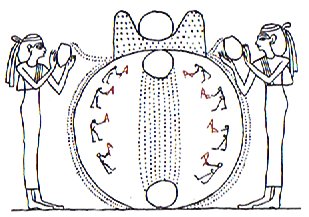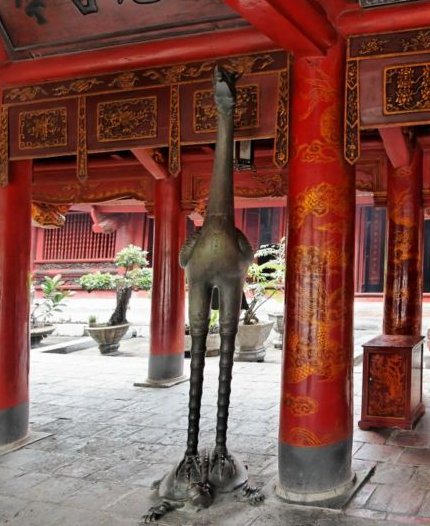|
TRANSLATIONS
My subconsious mind (kuhane) early in the morning has a chance to deliver some message to my slowly awakening senses. The message she told now was a picture (which is the only mode of speaking she has) of a steep mountain with water flowing down everywhere. I realized she meant Akapana: "... I walked towards it now, and spent some time strolling around it and clambering over it. Originally it had been a clean-sided step-pyramid of earth faced with large andesite blocks. In the centuries since the conquest, however, it had been used as a quarry by builders from as far away as La Paz, with the result that only about ten per cent of its superb facing blocks now remained.
What clues, what evidence, had those nameless thieves carried off with them? As I climbed up the broken sides and around the deep grassy troughs in the top of the Akapana, I realized that the true function of the pyramid was probably never going to be understood. All that was certain was that it had not been merely decorative or ceremonial. On the contrary, it seemed almost as though it might have functioned as some kind of arcane 'device' or machine. Deep within its bowels, archaeologists had discovered a complex network of zigzagging stone channels, lined with fine ashlars. These had been meticulously angled and jointed (to a tolerance of one-fiftieth of an inch), and had served to sluice water down from a large reservoir at the top of the structure, through a series of descending levels, to a moat that encircled the entire site, washing against the pyramid's base on its southern side ..." (Hancock) Akapana is situated in the south (toga). My thoughts then went on to the emergence of the sun beetle from the Hathor (necropolis) mountain, as illustrated in the Egyptian picture:
Hathor (Sirius) is important. Her belt (the cycle around the middle - perhaps seen in the picture as the circle around the beetle) was needed for the faraoh to be Faraoh:
The mountain at left in the picture looks as if the creator designed it to be the hind quarters of the Hathor cow. The billowing lines flows downwards and in between them we see many dots. I think this is meant to illustrate flowing water. In another Egyptian picture dot lines definitely are watery:
We now understand that the mountain with two peaks at the top also has water inside. ... Wilkinson says that in chapter 109 of the Book of the Dead two 'turquios sycomores' are standing at the eastern gate of the sky, where the sungod Ra enters. The sycomore was a manifestation of the 3 goddesses Nut, Isis, and Hathor, a manifestation by the name 'The Sycomore Lady' ... The water inside the mountain is not randomly distributed but follows 'well' defined circuits:
Once upon a time there was a cosmos evidently shared by all humans spread over the earth. This cosmos had a watery female mountain far up in the 'north'. On Easter Island they probably understood that, though they located the mountain in the south (toga). This is what my kuhane taught me to understand. Furthermore, the recapitulation of pictures and words made me realize that the growing (1st) phase of the year beyond the mountain is imprinted by the 'jaw' of Muri Ranga Whenua. Her 'jaw' is necessary for igniting new fire: The jaw in Ha6-6 for example: '... Is there a sign too, the pointed 'jaw' in Ha6-6? Yes, presumably there is ... The 'jaw' is similar to a toki. Toki is an instrument for working in wood, a male instrument. The sexual overtones are there. And we could also relate this train of thought to Ha6-3:
There is a tremendous amount of ideas swarming around the 1st phase of the year. Yet I cannot focus on more than one facet at once. The jaw means the left over part of the old henua. Regeneration presumes an earlier generation. We remember the Mayan numbers beyond 12:
The jawbones have the form of Y and we note that at 18 there suddenly is a reversal of the orientation of the bone - presumably because the sun turns around after 180 days. I believe Heyerdahl is correct in his view that the Polynesians (all three kinds: Maori, Pakepakeha and Manahune) migrated from America into the Pacific. Therefore we need support from American pictures and myths. As to the process of making fire I have just read about such things in "From Honey to Ashes": "... The myths refer to two techniques: friction or gyration, and percussion. According to M259, the fire which is now produced by friction was originally the fire vomited up by the frog, while M266 tells us that it was the crane, a bird to which another Guiana myth attributes a strong tendency to defecate, which instigated fire-kindling by percussion. Between these two myths, a third occupies an intermediary position: M272. Taulipang. 'The origin of fire' In olden times, when men still knew nothing of fire, there lived an old woman called Pelénosamó. One wonders if not the Hawaiian fire-mountain Pele has her name from Pelénosamó. ... According to Henry (1928, p. 115), also Tahitian folklore often spoke of Hawaii Island as Havai'i-a, or 'Burning Havai'i', due to its volcano which was formerly always brightly burning ... She piled wood up in her hearth and squatted on it. Flames then spurted from her anus and the wood caught fire. She ate her manioc cooked, whereas other people left theirs out in the heat of the sun. A little girl betrayed the old woman's secret. As she refused to give the fire, her arms and legs were bound, she was placed on some wood and her anus was forced open. Whereupon she excreted the fire, which changed into wató (= fire) stones, which make fire when they are rubbed together ... ... It is well known that fire-kindling techniques by gyration (or by friction) have a sexual connotation in various parts of the world, and certainly in South America: the passive wood is said to be female, the stick which is rotated, or moved back and forwards, is said to be male. The rhetoric used in the myth transposes this instantly and universally recognizable sexual symbolism by giving it imaginary expression, since the sexual act (copulation) is replaced by a phenomenon relating to the digestive apparatus (vomiting). Furthermore, the female who is passive on the symbolic level becomes active on the imaginary level, and the organs respectively concerned are in one instance the vagina, in the other the mouth, both definable in terms of a contrast between low and high, and both being at the same time anterior (along an axis the other pole of which is occupied by posterior orifices):
In the matter of fire-kindling techniques by percussion, ethnography provides no symbolic representations, the intuitive obviousness and general validity of which are comparable to those we have just mentioned. But M272, reinforced by the recurrent position occupied by the crane in the myths (the old woman who excretes, the bird which excretes, both of them masters of fire-making by percussion), enables us to deduce the unknown symbolism of this technique from its imaginary expression, which is all we have to go by. We merely have to apply the same transformation rules as we did in the preceding case, where they were empirically verifiable. We thus obtain the following equations:
Which organ, then, can be defined as posterior and high in a system in which the posterior, low position is occupied by the anus, and the anterior, high position by the mouth? We have no choice; it can only be the ear ... It follows, therefore, that on the imaginary (that is the mythic) level, vomiting is the opposite correlative to coitus, and defecation the opposite correlative of auditory communication. It is at once clear how experience confirms the hypothesis obtained by deduction; percussion is noisy, friction is silent. This explains why it was the crane which initiated the former ... for throughout the entire American continent and in other parts of the world too, myths are fond of introducing the crane because of its harsh cry23 ... 23 The cranes themselves seem to share this view, since an instance is quoted in which one of these birds, on losing its mate, developed a sentimental attachment to an iron bell, the sound of which reminded it of the cry of the absent bird ... As regards the harsh call of the crane in the myths of North America ... 'of all birds the Sandhill crane is the loudest and noisiest'. The Chippewa believe that members of the crane clan have powerful voices and are the tribe's orators ... As regards China ... 'The sound of the drum is heard as far away as Lo-yang when a white crane (italics in the text) flies right into the Gate of Thunder', and the reference to the Pi-fang bird, which 'resembles a crane, dances on one foot and produces fire' ... It is all the more legitimate to emphasize these parallels since there is an anatomical, hence objective, basis for the crane family's reputation for noise. 'In most species the wind-pipe is convoluted in the males (not always in the females), entering behind the clavicles into a hollow space in the keel of the sternum' ..."
(Wikipedia: crane on turtle - Hanoi) The long legs of the crane are divided into sections, and I can count to 9 bulges on each leg. 360 / 18 = 20. Probably their year is divided into 18 periods of 20 days, I think. One leg on each side of the turtle shell suggest that the shell symbolizes the year divided into 2 half-years. Why is a crane standing on the turtle? Applying the ideas of Lévi-Strauss I suppose the answer is: At winter solstice there is a turtle and there are also loud noices (drums, hootings, bells ringing, and the cracking of fireworks). Furthermore, the need of new fire should involve a turtle: "... the tortoise cannot be burnt ... a characteristic which is confirmed objectively by ethnography, since the wolf's trick [in M192] of trying to cook the tortoise while it was lying on its back is based on a method which may seem barbarous but is still current in central Brazil: the tortoise is so difficult to kill that the peasants cook it alive among the hot wood cinders, with its own shell acting as the cooking-dish; the process may last several hours, because the poor beast takes so long to die ..." (From Honey to Ashes) The celestial fires must surely be superhuman in intensity and greatness, therefore a turtle is needed at the bottom to function as an insulator, so as not the whole world will take fire.
Todays newspaper tells about the eel that it does not like the sun. When sun goes down in the evening the eel is immediately revitalized from his slumber at the bottom in the mud. The eel is a beast of the dark, a kind of polar opposite to the sun. I therefore guess it may be the sign of the eel we see for example at bottom left in Eb7-10:
Niu (GD18) - the world tree - presumably is twirled around and changing direction at winter solstice. |








